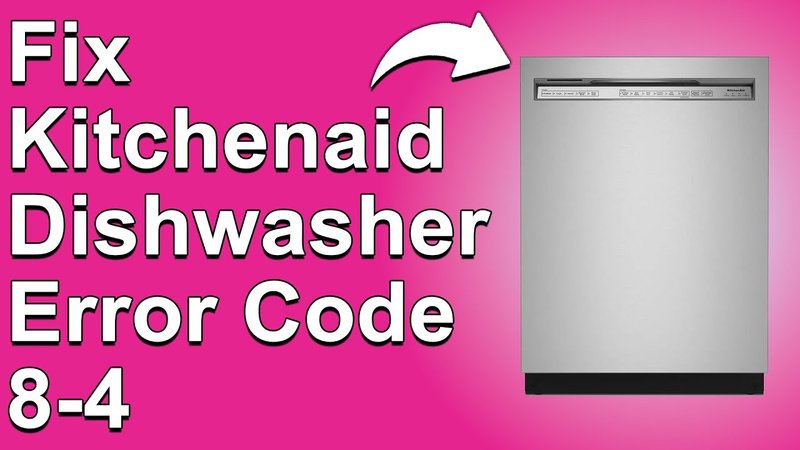
When you think of dishwashers, you wouldn’t expect error codes to be part of the package deal. But just like cars have warning lights, dishwashers have error codes to alert us when something’s amiss. Error Code E2 on a KitchenAid dishwasher often relates to an issue with the temperature sensor. It’s like when you’re cooking and can’t quite tell if the food is done because your oven thermometer’s on the fritz. This can lead to underheated water, which means your dishes aren’t getting as clean as they should. It can also mean using too much energy or even causing wear and tear if not addressed. So, how do we prevent this pesky error from popping up again?
Understanding the Causes of Error Code E2
Error Code E2 often points to a problem with the dishwasher’s temperature sensor. Think of this sensor like a thermometer that makes sure your dishwasher’s water is just right. If it’s malfunctioning, it’s like trying to cook with a broken oven dial — you’re working blind. This can lead to water that’s too cold to effectively clean, or too hot, risking damage to your delicate dishes and even the dishwasher itself.
One common cause is a faulty temperature sensor. Over time, just like an old battery that loses its charge, these sensors can wear down and start giving inaccurate readings. Without the correct temperature, your dishwasher’s system gets confused, leading to inefficient cycles and, eventually, that maddening Error Code E2. It’s crucial to regularly check and replace this sensor to ensure your dishwasher operates at its best.
Another potential culprit can be the wiring or connections to the sensor. Imagine trying to watch TV with a dodgy cable connection — the screen flickers, the sound drops. Similarly, if the connections to your temperature sensor are loose or corroded, it interrupts the signal, causing errors. Ensuring these connections are secure and in good condition can help prevent future mishaps. Lastly, a glitch in the dishwasher’s control board can occasionally trigger this error. While not as common, this is akin to your computer freezing up and needing a reboot. In such cases, resetting the dishwasher could be your first troubleshooting step.
Preventative Maintenance Tips
Routine maintenance is your best line of defense against Error Code E2. Imagine it like regular oil changes for your car — just a little attention goes a long way in keeping everything running smoothly. Start by regularly checking the temperature sensor and, if necessary, replace it. How do you do that? Well, look in the user manual for guidelines or consider calling a professional to ensure it’s done correctly. It’s like giving your dishwasher a mini check-up to keep it in top shape.
Keep an eye on the wiring. Loose wires can seem minor, but they can cause big headaches if ignored. Imagine trying to run a marathon with untied shoelaces — you’re likely to trip. Ensure all connections are tight and free from corrosion. Simply checking these every few months can save you a lot of trouble down the road.
Also, give your dishwasher a periodic clean. Residue buildup can affect many parts of the dishwasher, including the sensor. It’s like having a dusty lens on your camera — it won’t work properly until it’s clean. Run an empty cycle with a dishwasher cleaner every now and then to keep everything sparkling and functional. Remember, a little maintenance now can prevent a lot of stress later.
Dealing with Error Code E2 When It Strikes
So, Error Code E2 has popped up. What now? Don’t panic — think of it as a helpful nudge, like a low-fuel light in your car. Start by running a diagnostic test on your dishwasher, if your model allows it. This can sometimes help pinpoint the issue. If you’re unsure how to do this, check the manufacturer’s manual. It’s a bit like having a road map when you’re lost; it can lead you back to smooth operations.
Next, consider resetting your dishwasher. It’s a simple step that often resolves minor glitches, much like rebooting your computer when it acts up. Disconnect the power for a minute, then reconnect it. If the error persists, it might be time for a deeper dive into the potential causes.
If basic troubleshooting doesn’t do the trick, it might be time to call in the experts. Consider this like getting help from a mechanic for a complicated car issue. A professional technician can provide a thorough assessment and fix, ensuring your dishwasher is back in working order in no time. Remember, tackling issues promptly can prevent more significant problems down the line.
Final Thoughts and Future Prevention
Preventing Error Code E2 is all about being proactive and attentive. By understanding the causes, maintaining your dishwasher regularly, and knowing what to do when the error occurs, you can ensure that your trusty KitchenAid continues to provide clean dishes for years to come. It’s like maintaining a garden — with a little care and attention, everything continues to flourish.
If you’re vigilant about routine checks and don’t shy away from professional help when needed, you can keep Error Code E2 at bay. Keep your dishwasher running smoothly just as you would keep any other essential appliance in your home. After all, a little preventative care today can save a lot of stress and repair costs tomorrow. Happy dishwashing!